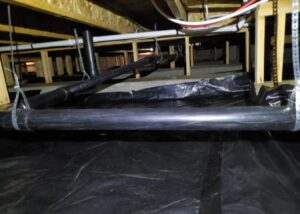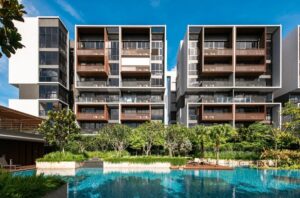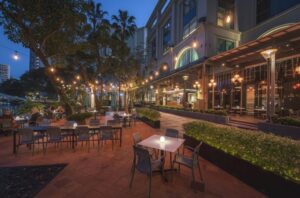Milan Mayor’s Desire To Cut Car Use Shared By Luxury Real Estate Developers

View from Milan’s Bosco Verticale down to BAM park and across to the UniCredit Tower.
The Milan HQ for Italian real estate developer COIMA—2,000 square meters of upscale glass and iron—sits at the junction of three busy roads: Via Melchiorre Gioia, Viale Luigi Sturzo, and Via Della Liberazione. The roads are flanked by new-build cycleways which, if Milan’s mayor gets his way, will become part of the most ambitious active travel network in the world.
Much of the four-lane Via Melchiorre Gioia has recently been topped with a vibrant park, the Biblioteca degli Alberi di Milano. Car-free and laced with footways, free open-air performances are often staged in the park, known to all as BAM.
A vertical forest, two apartment blocks covered with trees and shrubs, rises from one of corner of BAM. This is the COIMA-commissioned Bosco Verticale development, built in 2015. Across the way is the head office for the fashion brand Versace.
The Versace HQ in Milan at the junction of the three cycleway-flanked highways, Via Melchiorre … [+]
Modernist office buildings housing Google, Pirelli, and Alfa Romeo dot the wider Porta Nuova development, a former rail yard, derelict for many years but successfully redeveloped by COIMA and other real estate developers. (Porta Nuova is owned by the Persian Gulf’s Qatar Holding LLC, a unit of the emirate’s sovereign wealth fund.)
UniCredit—Italy’s largest bank—is headquartered in UniCredit Tower, which, thanks to its crafty spire, remains Italy’s tallest building. The 231-meter skyscraper has glorious views over BAM and its dreamcatcher grid of walkways.
“We developed BAM on behalf of the city of Milan; we manage it under an agreement with the city,” said COIMA’s sustainability officer Stefano Corbella.
We were talking in the early evening at the busy road junction opposite COIMA’s HQ, which opened in 2019. We walked through BAM, crowded with people heading to and from restaurants and shopping at still-open small market stalls. Motor traffic noise was reduced to almost nothing as we reached deeper into the park.
COIMA’s sustainability officer Stefano Corbella.
“There were no bike paths here before we started working on the project,” said Corbella.
“We added approximately four kilometers of cycling path integrated with other developments that the city of Milan was doing.”
“One of the challenges we faced when we started the design [for Porta Nuova] was that Via Melchiorre Gioia and Via Della Liberazione cut the entire site in the middle,” said Corbella.
Solution: bury them.
As well as carving out space for BAM, this highway capping also created a new public square, Piazza Gae Aulenti.
“To make the public spaces more appealing, we lifted everything by about six meters,” said Corbella.
Subtle landscaping disguised the height difference, gifting a scenic slope to a flat neighborhood.
“The area was derelict for decades after the rail yard closed,” remembered Corbella.
A down-at-the-heels fairground operated during the 1980s; plans in the 1990s to arrest the expanding urban decay didn’t leap from the drawing board.
“COIMA started the development of Porta Nuova in 2004, and finally, the project succeeded,” said Corbella.
The Mayor of Milan Giuseppe Sala at the Milan Gay Pride held at the Arco della Pace. Milan (Italy), … [+]
Several mayors have come and gone in that time, but all have supported the real estate developers working on different parts of the former Varese train station and its no-longer-needed rail yard. (Pelli Clarke Pelli designed the largest part of the development, the Garibaldi area near the Garibaldi railway station.)
What was once one of the most significant regeneration projects in Europe—much completed by the time Milan hosted the World Expo in 2015—is now one of the wealthiest districts in the world, with luxury residential, commercial, and business use.
Bankers, fund managers, and private equity investors live in swanky Porta Nuova apartments. Milan is Italy’s financial capital, and the bright lights—and generous tax breaks—of Porta Nuova attracted finance workers leaving London after the depredations of Brexit.
View from Bosco Verticale, COIMA’s “vertical forest.”
Milan has a lot going for it, not least its geography. It’s a short train journey to the financial center of Frankfurt, and it’s almost as quick to reach the Mediterranean coast or Alpine ski resorts. It’s a small city with excellent rail links and many tram lines. More than half of the city’s 1.4 million residents commute on public transit.
Those swanky apartments—close to the now all-important 15-minute-city-style amenities—will likely remain a good investment for some time. According to the real estate website Immobiliare.it, the value of luxury properties in Milan rose 25{3ad958c56c0e590d654b93674c26d25962f6afed4cc4b42be9279a39dd5a6531} to $6.3 billion in the six months ending in November last year. A 2021 report from the European Banking Authority stated that the number of high earners in Italy—individuals earning more than one million dollars a year—increased by 88{3ad958c56c0e590d654b93674c26d25962f6afed4cc4b42be9279a39dd5a6531} in 2020.
Milan is slowly but surely morphing into a global financial hub.
Goldman Sachs has shifted traders from London to Milan. UniCredit repatriated many employees from London after the U.K.’s disastrous 2016 decision to leave the E.U.
Climate control
Milan is one of the global cities in the C40 group, with nearly 100 cities taking action to confront the climate crisis. And, like many of those cities, Milan is getting serious about cycling. A network of 466 miles of separated cycleways should be completed by 2035, according to the city’s $285 million Cambio Biciplan, or “Change Bike Plan,” approved by the Metropolitan City of Milan in November 2021.
Still, the city has some ways to go: car dependency runs deep, and Milan has some of Europe’s worst pollution, exacerbated by winter-time temperature inversions.
View down to a cycleway from Bosco Verticale, Milan.
“Milan, like almost all European cities, has a large presence of cars,” Milan’s deputy mayor Arianna Censi told me. (She’s also the city’s mobility minister.)
“Over the last few years, the number of cars per inhabitant has decreased—in 2010 there were 54.16 cars per hundred inhabitants; in 2020 we reached 49.42—but we must continue to work to reduce the presence of cars on the road.”
This is not unpopular.
“We are going ahead with this policy because the citizens are asking us to,” Censi stressed.
Describing a district where parking lots were replaced with play areas and basketball and volleyball courts, she said this was an area “reconquered and returned to the neighborhood’s citizens” and that the municipality has to “make the city more liveable.”
Business executive Giuseppe Sala won 42{3ad958c56c0e590d654b93674c26d25962f6afed4cc4b42be9279a39dd5a6531} of the vote when, in 2016, he became Milan’s Mayor. He promised to transform Italy’s second most populous city for the better. He took space away from cars and handed it to people. During the pandemic, his administration added cycleways to main travel corridors and, with the Piazza Aperte (“open squares”) program, it created 38 pop-up community plazas, many of them in deprived areas where car use—and especially car parking—was endemic.
Sala was re-elected in 2021 on a substantially increased mandate. Taming car use can be a vote winner.
His administration’s Cambio Biciplan is still in its early stages, and Milan is not yet Amsterdam, but Rome wasn’t built in a day either.
Milan’s ambitious plan for a dense grid of cycleways.
The bike plan calls for a dense network of cycleways organized around four rings rippling out from the city center—a realization of a medieval street plan originally laid out around concentric canals, the Cerchia Interna, or Inner Ring. (Most of Milan’s historic canals were covered over in the mid-20th Century to make way for automobiles.)
The bicycle beltways will be linked by 16 speedy spoke-like cycleways connecting the city’s heart with the wider metropolitan area and leading to an outer ring of greenways meandering through woodlands and nature reserves. The cycleways will also link with light rail and tram stops.
“Our vision,” states Cambio Biciplan, “is a metropolitan city of Milan where more people travel by bicycle to work, school, shopping, picking up the children, having an aperitif, feeling safer, fitter, more productive.”
Olympic Village
There are plans for further cycleways—and a great deal of cycle parking—at COIMA’s new regeneration development at Porta Romana, another former rail yard, as the city prepares to host the Milan-Cortina 2026 Winter Olympics. Since last summer earth movers have been crawling over a lozenge of land near the Prada Foundation, an art gallery converted from an early 20th Century distillery.
The site will be home to the sustainable Olympic Village, designed by American engineering firm Skidmore, Owings & Merrill, after which it will become a mixed-use urban neighborhood, including student housing.
The Olympic Village plan for Porta Romana, Milan.
Developed by COIMA, Covivio, and Prada—along with funding from the Italian ESG group—the tender for the Porta Romana development was won in November 2020. However, the deal was delayed by legal battles. Late last year, Italy’s Council of State rejected an appeal giving the green light for the development.
The site’s buildings will be built to NZEB requirements (Nearly Zero Energy Building) and will be LEED certified. Under much of the site, there will be an underground car park mandated by a national parking minimums regulation.
“There is a national law which obliges new developments to provide parking spaces,” said COIMA’s Corbella.
“We have to provide a certain capacity even though we know we will probably never need such parking.”
View from the Prada Foundation art museum down to what will be Milan’s Winter Olympic Village at … [+]
The underground car parking will likely be converted to other uses. “The first level of parking will have a slightly higher floor-to-ceiling height,” said Corbella, adding that the developer would “repurpose that area in the future otherwise we will have created space for nothing.”
COIMA’s sustainability officer hopes that the parking minimums law will be repealed.
“In some places, it totally makes sense not to push for parking because it won’t be needed; it’s a waste of money to provide it,” he said.
Milan has to follow this law, but there are many other measures that can green a city.
“Milan’s mindset has changed a lot,” said Corbella.
“I remember 15 or 20 years ago when the city was skeptical about planting trees; now the city has a plan to plant three million of them.”
And, like in Paris, newly planted trees often take the place of street parking.
“With fewer cars, Milan is already a more pleasant city,” nodded Corbella.
“Soon it will be even more pleasant.”








